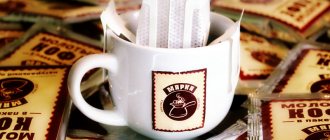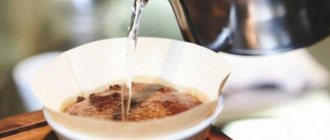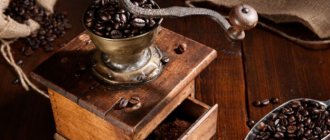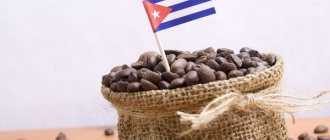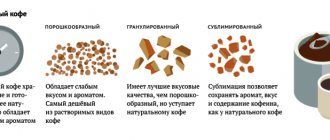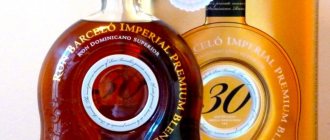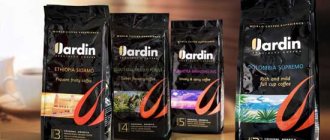Flavored coffee is not a new product in recent decades. Its history goes back many centuries. The first to perfect the drink were residents of the Middle East, who added various spices to it when cooking: cinnamon, cardamom, vanilla. Therefore, statements by connoisseurs of all things natural that modern marketers have spoiled the true taste of an invigorating drink with additives are absolutely groundless. Today, flavoring is not limited to a set of spices and herbs, and on store shelves you can find coffee with the most incredible additions.
What types of coffee are there?
All types and varieties of coffee can be divided into 4 main groups, by which the type of drink is determined. In particular, there are such varieties as:
- Arabica;
- robusta;
- excelsa;
- liberica.
Each group has its own specific properties and differs in grains and taste. Much depends on the country and area where it grows. The main varieties are Robusta and Arabica. Liberica and Excelsa have a very intense bitter taste, so they are added to other varieties to give a more original bouquet.
Arabica has a soft, delicate taste and contains a minimum of caffeine. The result is a pleasant drink with a light aroma. The coffee tree itself is very capricious. People highly value Arabica, which is grown only on mountain slopes.
Robusta is an unpretentious tree that can withstand temperature changes and depleted soil, while producing a large number of fruits. However, its beans contain quite a lot of caffeine, which imparts bitterness. But he also has admirers.
Making coffee at home using a Turk
The Turk is a unique item designed for brewing coffee at home. This device appeared far before our generation. In ancient times, people used it to make truly wonderful coffee.
The quality and result depend a lot on what the Turk is made of.
- When choosing a clay pot, you need to take into account that it is best to prepare one type of coffee in it, since its walls are able to absorb odors. Ultimately, this can spoil the taste of different coffees.
- The pot made of ceramic is quite fragile, but the drink obtained from it is the most rich and high-quality.
- Turka of their copper alloy is considered the most common, but thick walls are required for the richness of the drink. In such a Turk, the transfer of taste qualities stops at 90%.
It is imperative to take into account that the Turk should have a narrow neck and a wide bottom. The existing liquid and flavors evaporate more slowly.
Features of flavored coffee
This is an interesting new product. Many people constantly add various spices and toppings in the form of milk and cream to this drink. Some even add orange zest. Coffee can be prepared in various ways, choosing the most delicious option for yourself.
It is quite possible to make an aromatic drink yourself by adding cloves, cinnamon, cardamom, and other herbs and spices. However, such complex flavors as amaretto, caramel and Turin chocolate are much more difficult to reproduce on your own. In this case, you can purchase flavored coffee.
Manufacturers produce it in different flavors. To produce flavored coffee beans, natural components, as well as substances obtained by chemical means, can be used. The difference is that the former have a softer and more natural taste, while the latter have bright and rich properties.
To produce flavored coffee beans, premium grade Arabica products of varying degrees of roasting are used, which are then saturated by spraying special additives on them. Sometimes only the grain packaging is processed. In this case, the coffee acquires only a slight aroma. The most important thing is to strictly follow the technology.
It is worth storing the grains in an airtight and dry container so that the aroma does not evaporate. It is better to grind them in a coffee grinder just before consumption in the required quantity.
What kind of coffee is flavored?
Having had enough of the flowery names of flavored coffee, it’s time to ask yourself the question - what types of coffee are generally processed in order to enhance or change the taste?
The question is not idle, if you remember the history of flavored grains.
- It is believed that they first appeared about 500 years ago. Natural flavorings included cloves, peppercorns, cinnamon, and vanilla.
- Spices were not used to pamper customers. They were needed to mask the musty taste and stale aroma of the grains.
We are far from thinking that modern producers use aromatic substances to correct the flaws of varieties or storage deficiencies, but we have never heard of elite and simply high-quality single varieties being aromatized.
On packages of flavored coffee you can usually see the inscription - 100% Arabica. But Arabica can be different, including not very successful. We can conclude that flavoring involves blends of a wide variety of grains, which are not very impressive with their taste characteristics. There are plenty of these in any harvest. So they are flavored for subsequent profitable sale.
Harm and benefit
Flavored coffee has a unique taste and smell. It's just a great way to please yourself. For example, you can drink a cup of liqueur-flavored drink and not be afraid to drive a car, since it contains no alcohol. In addition, you can enjoy chocolate-flavored coffee without fear of ruining your figure.
However, if you drink too much of this drink, you can harm your health. Many people consume ground flavored coffee in large quantities, and this can cause harm to the cardiovascular system. In addition, when grains are specially processed, beneficial components disappear from them, as well as antioxidants that slow down the aging process. However, if you observe the moderation of consumption of this drink, you can enjoy the unique taste and aroma.
Myths about the harmful effects of coffee
- Myth number one.
Chemical ingredients are added to coffee that has a particular aroma. Let's not argue, this is possible. In the event that you buy an inadequately cheap product from an unknown manufacturer or without any indication of the brand; here, “nature-identical” flavors may well be the result of chemical synthesis. Branded flavored coffee beans from a trusted supplier are a high-quality product that is processed exclusively with natural extracts. - Myth number two.
The aromatic drink does not have as much caffeine, and therefore a person drinks more of it - and this is fraught with an overdose and greater stress on the blood vessels and heart. Yes, such flavored coffee is harmful in large quantities... exactly the same as normal. According to nutritionists, the daily safe norm includes 2-4 cups of the drink, depending on the amount of caffeine it contains. This should be taken into account by all coffee lovers, regardless of whether they like classic coffee or with added aromas. - Myth number three.
When aromatizing coffee beans, many beneficial substances are “killed,” in particular antioxidants, vitamins, and organic acids. To understand the groundlessness of such statements, let us recall modern aromatization techniques. Natural oil extracts are either sprayed in microscopic particles onto the surface of the finished beans or packaging, or added during roasting. Of course, this process cannot in any way affect the natural composition of the coffee.
Well, now - enjoy your breakfast, accompanied by a cup of coffee with your favorite smell and taste!
People are divided into two types: those who are indifferent to coffee, and those who cannot imagine their life without it. We belong to the latter and never tire of declaring our love for this invigorating drink.
It has been scientifically proven that coffee increases performance, strengthens the immune system, improves brain function, reduces the risk of diabetes, Parkinson's disease and a number of cancers. Coffee also creates a boundless atmosphere of comfort and happiness around itself. How can you not love this drink?
KitchenMag asked professionals how to learn to understand the coffee world and what you need to know to choose the best and most aromatic coffee.
It is difficult to name the exact number of coffee varieties. There is an opinion among people that there are 2 types of coffee, Arabica and Robusta, but this is not true. Arabica and Robusta are not varieties, but varieties of coffee,
which are grown on an industrial scale. How are they different from each other? Arabica has a brighter aroma and delicate taste than robusta and contains less caffeine. Robusta is stronger, bitter and astringent.
Then what is a type of coffee? Manufacturers often name coffee varieties after the names of the regions in which the coffee beans are grown.
For example, among the grains grown in Africa, the most popular are those from Kenya and Ethiopia, in South America - from Colombia and Costa Rica.
Coffee varieties differ from each other not only by region, but also by taste.
Kenya is a truly berry coffee, sweet taste and notes of caramel, while Costa Rica has bready and nutty tones in the aroma, the taste goes from bright citrus and nutty to a caramel aftertaste.
So how do you choose from such a variety the variety that you like? The answer is simple - it all depends on your preferences.
The most important thing is to buy the highest quality coffee in
specialized stores
so as not to be disappointed. Traveler's coffee gives you the opportunity to purchase Specialty coffee directly in the coffee shop, where experienced baristas will help you choose the right taste.
To discover the full taste and aroma of coffee, try alternative methods of brewing coffee. I love the single variety Ethiopia Guji Sasabo, brewed with apple juice, cinnamon and lime juice. Don't be afraid to experiment and discover coffee from different angles!
Natalia Smirnova
owner of the coffee bar O!COFFEE
To choose and prepare the perfect coffee for yourself, you need to understand several issues: the quality of the coffee bean, the degree of roasting and the correct brewing method.
The most famous types of coffee trees are Arabica and Robusta. Robusta is unpretentious in care, it contains more caffeine, and its taste component is natural bitterness. Arabica requires care, better growing conditions, it is softer, with natural acidity and bright aromatics. Further, the types of coffee tree are divided into varieties or single varieties - these are coffee beans grown in a particular region or even on one plantation. Each single variety has its own unique taste and aroma component.
Global giants, suppliers of roasted coffee beans most often offer us a blend, that is, a mixture of different varieties of Arabica, and more often - Arabica and Robusta.
This is both simpler and cheaper, but not as interesting, since the bitterness of Robusta can overshadow the unique and inimitable flavor shades of pure Arabica.
It’s better to go into the fascinating world of coffee with 100% Arabica, and then experiment.
Try single varieties - each of them is capable of giving different taste sensations and different emotions. In one you can catch the sourness of citrus fruits, in another - the sweetness of a red apple, in the third - the spiciness of almonds.
Which roast should you choose?
It all depends greatly on the method used to brew the coffee. There are three types of roast: light, medium and dark. The more deeply the coffee is roasted, the more difficult it is to distinguish between the different flavors. In a professional coffee machine it is better to brew a medium or dark roast; at home, in an alternative - a Turk, an AeroPress, a geyser coffee maker - a light roast will show itself more clearly.
the Aeropress , for example.
. Coffee brewed with it turns out dense and rich, and can be enjoyed for a long time. As it cools, it reveals new flavors and becomes more and more interesting.
I'll tell you a few simple steps
, which will help you choose the best coffee.
1. Where?
It is best to buy coffee in coffee shops, since, unfortunately, I do not yet know of stores where almost the entire range of coffee would not be “old”.
2. Freshness
The coffee should be roasted no more than 4-5 weeks ago. After this period, the coffee taste changes greatly, rancidity appears, and we will no longer be able to get a great cup of coffee. And all this despite the fact that roasted coffee typically has a shelf life of 18 months. Therefore, I recommend drinking coffee from local roasters, although this is not a panacea. If you can bring coffee from other countries within the specified time frame, then why not!
When purchasing coffee, you should at a minimum see where the coffee came from, as well as the region where the beans grew, how they were processed, and the year they were harvested. For example: Ethiopia Nano Chala, Agaro zone, altitude 2000 meters, harvest November-December 2015. If, when choosing coffee, you see, for example, only the inscription Ethiopia or Colombia, then keep in mind that, most likely, you will receive a drink with a weak bouquet and taste.
Unusual in taste and very popular, this is a rather ancient drink. It was invented almost a thousand years ago, and previously it was brewed with the addition of spices, fruits, and sometimes even flowers, which made it possible to get rid of the characteristic bitterness and change the aroma and taste of the finished drink. Nowadays this coffee is still brewed in different countries, and over time it has turned into a real dessert.
What are the types
Experts divide flavored coffee into four main groups, namely:
- floral-fruity;
- nut and milk;
- chocolate;
- alcoholic.
Alcoholic varieties include amaretto and Irish whiskey. The first is characterized by the special taste of a coffee drink, complemented by the soft aroma of liqueur. The second is a pleasant and rich drink with a bright aftertaste of Irish whiskey.
The nut and milk group includes:
- Hawaiian nut – a tart drink with a nut aroma;
- vanilla cream – the coffee tastes of cream and sweet vanilla;
- Creamy Almond – The coffee bitterness goes well with the almond flavor.
The flower and fruit group is quite diverse. These include:
- cinnamon – a strong drink complemented by a rich spice aroma;
- blood orange – has an invigorating note and freshness of citrus in its taste;
- cardamom is an original combination for those who love a tart or spicy taste;
- coffee with cream should be classified as a dessert; After consuming the drink, a hint of sweet strawberry remains.
Chocolate types include almonds, tiramisu and Bavarian chocolate. Tiramisu is well suited for all lovers of this famous dessert. It adds sweetness to the drink. Bavarian chocolate is a dessert coffee with a sweetish, pleasant aftertaste. Chocolate almonds combine the sweetness of chocolate and the slight flavor of almonds.
Who can I recommend to buy flavored coffee?
It is difficult to guess the taste preferences of each person, and not everyone likes flavored varieties. But, as our experience shows, people willingly try original tastes:
- Creative and inquisitive natures who value new impressions and sensations. They are especially captivated by unusual combinations, for example, Chocolate Orange or Vanilla Almond.
- Beginner coffee drinkers who want to tone down the traditional bitterness of natural beans. They love flavored dessert varieties - French tiramisu, Strawberries and cream.
- Sweet tooth and gourmands. They just can't go past Bavarian Chocolate, Fudge, Hawaiian Nut or Caramel.
Coffee gourmets are not too fond of flavored coffee, since beans of vague origin, treated with artificial aroma, according to connoisseurs, have little in common with the noble drink.
What beans are used
The type of bean greatly affects the taste of the finished drink. It is believed that coffee beans contain more than 800 different compounds that affect taste. In particular, they include:
- organic acids;
- carbohydrates;
- mineral salts;
- sugar;
- aroma oils;
- caffeine.
The taste of coffee beans largely depends on where they grow and how exactly they were roasted. The name is generally indicated by country of origin along with additional information. Arabica beans are mainly used for flavoring, as they have a low level of bitterness and acidity.
What additives are used
To make flavored coffee beans, natural or synthetic additives are used. Natural oils are extracted from a variety of sources, including vanilla, cocoa beans, berries and nuts. Also, cloves, cinnamon, and chicory are often used in coffee aromas.
Synthetic flavor comes from chemicals. It can be a woody or nutty aroma and is made with 2,4 dimethyl-5-acetylthiazole. Several different oils are mixed to achieve specific flavor aromas. Coffee flavorings can include up to 80 different compounds. Almost any taste and smell can be reproduced.
Pure flavor compounds are highly concentrated and must be diluted in a solvent. For this purpose, alcohol, water, vegetable oils, and propylene glycol are used. These solvents are removed from the coffee beans through drying.
How it is made
Modern technologies make it easy to make grain and instant flavored coffee. Many people prefer to try new, even the most unusual options and flavor combinations.
However, not everyone knows how flavored coffee is made. You can add flavor to the beans using packaging. To do this, aromatic substances are sprayed onto its inner side using a spray bottle. This technology makes it possible to process paper bags and cans.
Flavoring occurs at the moment when the still empty can moves along the conveyor. Then the beans are poured into the container, which over time acquire a stable aroma, but will not change their rich coffee taste.
Flavoring of grains occurs using almost the same technology. To do this, aromatic substances are sprayed onto the beans. This allows you to change the taste and aroma of the finished drink. Additional notes appear in it, depending on what additives were used.
You can also make flavored coffee using a coffee machine. To do this, take grains. Which are ground in a coffee grinder and only after that pass through flavored steam and hot water in a coffee machine or coffee machine. This way you can brew the desired type of drink. You can create unique, simply amazing treats.
What is flavored coffee and how is it produced?
Manufacturers' technological tricks make it possible to impart a variety of flavors to natural grains.
The process of treating coffee beans to change or enhance their aromatic composition is called aromatization, and coffee that has undergone such processing is aromatized.
How can you change the natural taste and smell of coffee beans? There are three main ways.
- Packaging processing
. In this case, an aqueous solution of the selected extract is sprayed onto the inside of the foil package. Next, place the coffee beans and seal the bag tightly. - Grain processing
. The aromatic extract is sprayed directly onto the beans before vacuum packaging. This is how coffee is obtained not only with the selected smell, but with a changed taste, enriching it with new notes. - Processing of ground powder
. Freshly ground grains are passed through hot water with the addition of an aromatic composition or treated with hot steam that rises from boiling water with aromas. The powder can then be vacuum packed. The latter method of flavoring is available to everyone, so it is sometimes used in cafes, bars and restaurants, processing ground coffee immediately before preparation.
There is another type of flavoring when natural spices are added to the grains during roasting. But this method allows you to obtain a relatively small range of flavors, and natural spices are more expensive than artificial flavors, so it is not used on an industrial scale. Coffee flavored in this way can be ordered from private roasters.
How are fragrance oils added?
Flavoring additives are mainly added to freshly roasted coffee beans. They are placed in a large mixer that is specially designed for this purpose. In it, the grains fall softly and are not damaged.
Fragrances are introduced primarily through a pressurized mechanism through atomization. As a result, the oils turn into microscopic droplets, which promotes better mixing. Oils should be added gradually to prevent the formation of areas of high flavor concentration.
The beans need to be stirred for a certain amount of time to ensure even distribution of flavor. This process takes approximately 15-30 minutes, depending on the characteristics of the oil and the size of the batch. When the grains are completely coated with oil, they become glossy.
Flavorings are also used in dry form. In this case, they are mixed with ground coffee. The flavors are enclosed in starch or other powdered composition.
Aromatization of ground and instant coffee
Flavorings are added to ground grains in dry form, enclosing the concentrate in capsules. The moisture contained in coffee helps the flavor and aroma spread over a 24-hour period. To avoid loss of the obtained properties, the product is packaged as quickly as possible. To limit the contact of coffee with oxygen, the containers are purged with nitrogen. This technique allows you to preserve aromas for up to two to three years.
Instant coffee is flavored in different ways. Additives are mixed with coffee extract or added to the finished product after spray or freeze drying.
Among the innovative methods are special filters for coffee machines that contain flavorings. In this case, the consumer himself chooses what kind of coffee to drink - regular or with a certain taste.
Package
Naturally flavored coffee is bagged or canned as quickly as possible and sealed to prevent exposure to oxygen. Before packaging, the container is purged with nitrogen to remove air from the container.
Oxygen can react with components of essential oils and grains, resulting in deterioration in the quality of the finished product. Roasted coffee, after contact with air, begins to release its essential oils. Treating the container with nitrogen before filling it pushes out all the oxygen and ensures long-lasting freshness.
Flavored coffee should be stored in a cool, dark place if it will be used within 3-4 weeks. If longer storage is required, the grains can be frozen.
How to choose a quality product
Flavored coffee reviews mostly receive positive reviews, as many people like unusual flavor combinations. However, to enjoy a delicious drink, you need to choose the right grains. Their surface should be slightly oily. This indicates that they are soaked in sufficient quantities of aromatic oils.
Try taking one coffee bean and rubbing it in your hands. If you can smell the aroma, then it is a quality product. In addition, you need to pay attention to its expiration date, composition of flavors and storage conditions in the store.
Making coffee beans in a saucepan at home
You can prepare delicious and aromatic coffee without special equipment. A regular saucepan will do for this. First of all, you need to decide how many servings of the drink you need. If you only need one serving, then it is best to take a pan as small as possible. There is no need to prepare the drink for the whole day, because the taste and aroma qualities are completely lost. I drink this drink immediately after preparation.
Experts suggest using coarsely ground coffee in a saucepan. As in Turk, coffee is boiled until a foamy layer forms. Do not allow it to boil under any circumstances. Once cooked, remove the pan from the heat and allow it to steep for about 3 minutes.
There are many recipes for brewing coffee using a saucepan at home.
How to make your own aromatic drink
To do this, you need to take coffee beans, herbs and spices, and essential oils from herbs. Take a dry and clean glass jar and pour 100-200 g of coffee beans into it. Place spices in a jar in a ratio of 1:3. They should be whole and not crushed, otherwise strong bitterness may appear.
Close the jar and shake everything well. Place in a dry, dark place for 5-6 days. When the grains absorb the aroma of spices, carefully sort them out and separate them from additives. Then prepare coffee in the usual way. Edible oils can also be used for flavoring.
How to brew correctly
Many people are interested in whether it is possible to put flavored coffee into a coffee machine, and how best to prepare it. It is recommended to brew it in a Turk or French press, as aromatic oils can clog the coffee grinder of the coffee machine, which will lead to its breakdown.
You can make very tasty coffee. To do this, beat the ice and cream until foam forms, add a little coconut syrup. Place a little condensed milk in a glass, pour in the prepared mixture and coffee in small portions. If everything is done correctly, then all components will be placed in layers. Serve the drink with a straw.
Can you use flavored coffee in a coffee machine?
According to statistics, coffee machines in which a flavored drink was brewed are more likely to fail. This is because most flavors are oil-based, which makes the beans and coffee powder stickier. Waste adhesive coffee mass can cause several types of breakdowns:
- the plastic in the grinding compartment is damaged;
- The knives and millstones of the coffee grinder wear out quickly;
- The plastic brewing mechanism fails faster due to the accumulation of impregnated flavors on it and increased friction.
It is possible to brew flavored coffee in a coffee machine, but this may cause faster wear and tear on the consumables. Modern machines made from high-quality wear-resistant materials can easily cope with such a load.
Another reason why it is not recommended to use a coffee machine is the smell of the product. No matter how pleasant it is, it is very difficult to remove it from the coffee machine. Any coffee you make later will be infused with flavor.
Have you tried flavored coffee?
Yes
No
